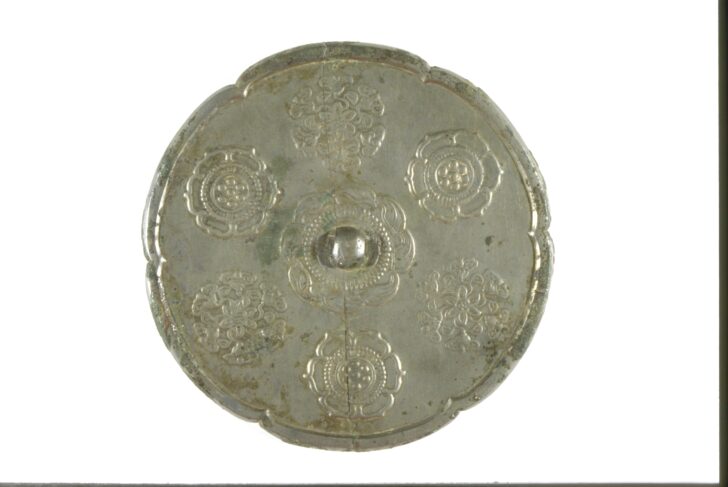Mirror, Baoxiang-hua type (with designs of floral medallions)
Chinese

Description
Subject Matter:
Bronze mirrors, the treasures in ancient Chinese bronze cultural heritage, are well- made, beautiful in appearance, gorgeous in patterns, and rich in inscriptions. The development of bronze mirrors in the Tang Dynasty was mainly due to the facts that the porcelain had replaced copper, the bronzes had declined, the bronze techniques were concentrated on bronze mirrors, and the bronze mirrors were used as gifts in social interactions. The bronze mirror in the Tang Dynasty broke through Han-style mirrors such as sunflower mirrors, rhombus mirrors and square mirrors.
The Baoxiang pattern is a typical Chinese traditional decorative pattern, created by a recombination of natural materials, such as blooming flowers, leaflets of flowers, flowers containing flowers, buds and leaves of flowers as the law of radiation symmetry or other artistic approaches. The decorative pattern is inspired by the artistic beauty of metal jewelry and the natural beauty of many flowers. Baoxiang pattern enjoyed the most popularity in the Tang Dynasty.
Bao Xiang flower is also known as Bao Xian flower. Based on the pattern characteristics of lotus, lotus, and peony, it is also drawn from the floral decorations such as peony and rose, the reason for its another name “ Baoxiang Lotus”. Baoxiang flower was the most time-characteristic flower form in the Tang Dynasty, and a modeling flower pattern. The Baoxiang pattern was mainly consist of lotus flowers, honeysuckle, pomegranate, mois, and peony, Patterns, beads, etc. These patterns have different signifiers and signfied. Baoxiang flower is a combination pattern of all those patterns, becoming one of the relatively abstract and modeling forms of floral patterns.
As a traditional Chinese decorative pattern, Baoxiang pattern gradually forms auspicious patterns with Chinese national characteristics along with the re- placement of the dynasties and the passage of time, and has been widely applied. And its artistic form and its formation in symbol connotation have deep cultural connotations. Its formal beauty is more closely inte- grated with the symbolic meaning of auspiciousness, prosperity and happiness.
Yingxu, Liu. “ The Study on the Boxing Pattern of the Bronze Mirror in the Tang Dynasty .” Sodruzhestvo International Journal. Art Criticism., pp. 21–22.
Physical Description:
A circular mirror with the rim made to look like flower petals. On the surface are six designs of floral medallions. There is a little ball in the center of the surface of the mirror with another floral medallion surrounding it.
Usage Rights:
If you are interested in using an image for a publication, please visit https://umma.umich.edu/request-image/ for more information and to fill out the online Image Rights and Reproductions Request Form.